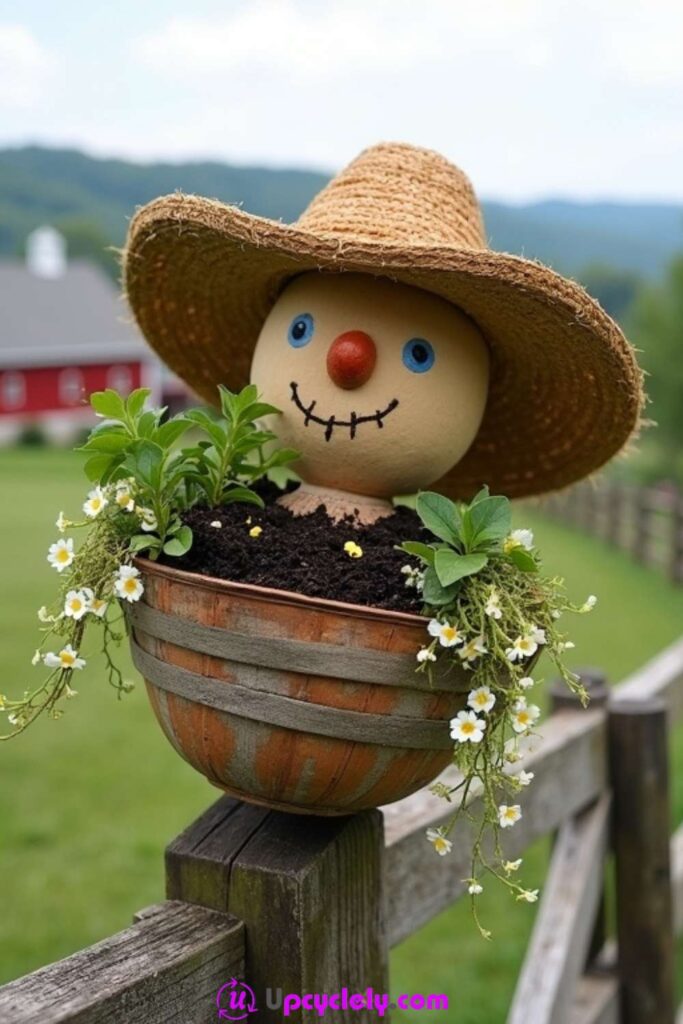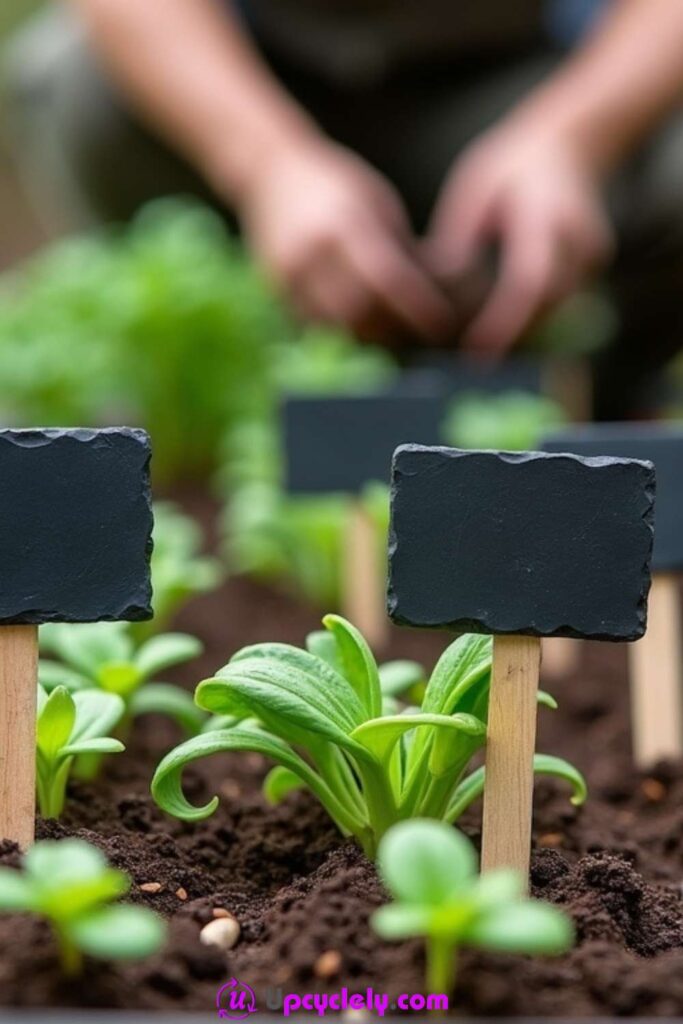Scarecrow Hat Planter

Materials Needed:
- A small clay or ceramic pot (for the planter)
- A styrofoam ball or foam head (to create the scarecrow’s face)
- Straw hat (the classic scarecrow style)
- Fresh flowers or small plants (for planting)
- Potting soil
- Hot glue gun and glue sticks
- Black marker (for drawing a smile or face)
Steps:
- Create the Base
Start by placing your styrofoam ball on top of the clay pot. You’ll need to make sure it fits snugly, so you might need to cut a small hole in the foam to help it sit securely on the pot. This is where the magic happens – you’re building the face of your scarecrow! - Dress the Scarecrow
Once the foam ball is firmly attached, grab your straw hat and carefully place it over the foam head. You can use a dab of hot glue to ensure it stays put, but be careful not to overdo it, as you want the look to be casual and fun, not too rigid. - Add Plants
Fill the clay pot with potting soil and add your chosen flowers or plants. I love using bright, cheerful flowers like daisies or marigolds. Not only do they look great, but they give the scarecrow a lively, inviting feel in your garden.
Pro Tip:
Use flowers that thrive in the same climate as your garden. It’s also a nice touch to give the foam face a little personality – draw a smile and eyes with a marker for that classic scarecrow charm!
Chalkboard Plant Labels

Materials Needed:
- Small rectangular chalkboard pieces or wooden plant labels
- Chalk or chalk markers
- Hot glue gun
- Small sticks or dowels (for mounting the labels)
Steps:
- Prepare the Labels
Grab your chalkboard labels or make your own by cutting rectangular pieces of wood and painting them with chalkboard paint. Once dry, attach a small stick or dowel to the bottom of each label with a hot glue gun. - Write Your Plant Names
Using chalk or a chalk marker, label each board with the name of your plants. Get creative with the font and style, and make sure the labels are legible and neat. This step is both practical and fun – it helps you stay organized while adding a personal touch to your garden. - Mount the Labels
Push the dowels into the soil next to the respective plants. These labels will help you easily identify your herbs, vegetables, or flowers.
Pro Tip:
If you don’t want to rewrite the plant names every season, try using chalk markers – they last longer and are easier to erase. This is especially helpful if you plan to reuse the labels for different plants in the future.
Hanging Gutter Herb Garden

Materials Needed:
- Old gutters or metal piping
- Mounting brackets (for attaching to the fence)
- Potting soil
- Herb plants (like basil, rosemary, thyme)
- Drill and screws
- Small stones (for drainage)
Steps:
- Prepare the Gutters
Cut your gutters to a manageable size, depending on how long you want your garden to be. Clean them well to ensure no debris or dirt is left behind. Mount them onto the fence or wall using the brackets and screws. Make sure they are level to ensure water drains properly. - Add Drainage and Soil
Place a layer of small stones at the bottom of the gutters to allow for proper drainage. This step is crucial – without it, your plants may drown in excess water. Fill the gutters with potting soil, but leave about an inch from the top to prevent water from spilling over when it rains. - Plant Your Herbs
Gently plant your herbs into the soil. You can plant multiple herbs in each gutter, depending on the size. Make sure they’re spaced out to give each plant room to grow.
Pro Tip:
Consider using gutters that have a bit of a curve to them – this helps the water drain away better. Also, make sure to pick herbs that don’t need excessive sunlight or space – they thrive in a confined environment and will create a lovely, aromatic display.
Miniature Pond in a Wheelbarrow

Materials Needed:
- Old wheelbarrow (preferably metal)
- Plastic liner (to hold the water)
- Water lilies or floating plants
- Stones for decoration
- Candles or LED lights (for ambiance)
- Water (obviously)
Steps:
- Prepare the Wheelbarrow
Line the inside of the wheelbarrow with a plastic liner. This will prevent the water from leaking out and help retain the pond’s shape. Trim the liner to fit neatly within the wheelbarrow’s curves. - Add Water and Plants
Fill the wheelbarrow with water, leaving about an inch of space from the top. Then, carefully place water lilies or any other floating plants into the water. The lilies not only look beautiful but also help keep the water clean. - Add Decorative Touches
Scatter some stones around the base of the plants to add texture and interest. For a peaceful ambiance, add floating candles or LED lights. These will give a soft glow at night, creating a serene garden feature.
Pro Tip:
If you don’t want to worry about your wheelbarrow pond freezing during the winter, simply cover it with a tarp or plastic sheet. You can also place a solar-powered fountain in the water to keep it moving, which will help with aeration and prevent stagnant water.
Painted Garden Stones

Materials Needed:
- Smooth, round stones (about the size of a small apple or pear)
- Acrylic paint (various colors like red, yellow, green, and orange)
- Paintbrushes
- Clear sealant (to protect the paint)
- Small containers or baskets (to display the fruits)
Steps:
- Choose Your Stones
Begin by selecting smooth stones that resemble fruit shapes. This could be small, round stones for apples or pears, or slightly larger, oval-shaped ones for melons or pumpkins. Make sure they’re clean and dry before you start painting. - Paint the Fruits
Once your stones are ready, start painting them with your chosen fruit colors. For example, use red for apples, yellow for lemons, and orange for oranges. You can get creative and add shading or details to make them look even more realistic, like drawing little leaf shapes on top of the fruit. Allow the paint to dry completely before applying another coat if needed. - Seal and Display
Once the paint is dry, apply a clear acrylic sealant to protect the painted design from the elements. This will help keep your fruit stones looking vibrant, especially if you plan to place them outdoors. Once sealed, you can arrange them in small containers or baskets for display around your garden.
Pro Tip:
Consider using these painted stones as a fun, whimsical touch in your vegetable garden or as decor in outdoor planters. They add a playful vibe and can even serve as a conversation starter when guests come over.
Painted Rock Garden Markers

Materials Needed:
- Medium to large flat stones
- Acrylic paint (green, white, black, and any other colors you like)
- Paintbrushes
- Permanent markers (optional)
- Clear acrylic sealant spray
Steps:
- Choose and Clean the Stones
Pick smooth, flat stones that will work well as markers for your garden. Wash them thoroughly to remove any dirt or debris, then let them dry completely before you begin painting. - Paint the Stones
Using your acrylic paint, create designs that represent the plants you’ll be marking. For example, you can paint the word “Basil” on one stone, or create simple images of the plant next to its name. For added detail, use a fine-tipped marker to draw intricate leaves, flowers, or stems on the stones. Be sure to let each layer dry before adding more paint. - Seal and Place
Once the paint is completely dry, spray a coat of clear acrylic sealant to protect your designs from the elements. This will make sure your garden markers last through the seasons. Once sealed, place the stones in your garden, either next to the plants they represent or in the flower beds to add a colorful touch.
Pro Tip:
For a more personalized touch, you can write the names of the plants in fancy calligraphy or paint a small design representing the plant. For example, a sun symbol for tomatoes, a vine for cucumbers, and so on.
Rainbow Bottle Edging

Materials Needed:
- Old glass bottles (green, blue, clear, red, etc.)
- A sturdy shovel or trowel
- Strong adhesive (like concrete glue or epoxy)
- Outdoor sand or gravel (to help stabilize the bottles in the ground)
Steps:
- Prepare the Area
Decide where you want to add your rainbow bottle edging – this could be along a flower bed, garden path, or around your vegetable garden. Dig a shallow trench about 3-4 inches deep where you want the bottles to stand. - Place the Bottles
Start placing your glass bottles into the trench, arranging them by color to create a vibrant rainbow pattern. You can alternate the bottle colors to achieve a pattern, or go for a gradient effect. Push the bottles into the ground, making sure they are firmly set. If needed, add a layer of sand or gravel to help hold them in place. - Glue and Finish
Once your bottles are in place, use a strong adhesive to secure them together. This will help keep the bottles stable, especially if you’re using them as a barrier or edging. Allow the glue to dry completely before moving or working around the bottles.
Pro Tip:
This project works best if you can find old, colorful glass bottles. Don’t worry if they’re not perfectly matching; the randomness of color adds to the charm. You can also try using different-sized bottles to create a more interesting texture.


